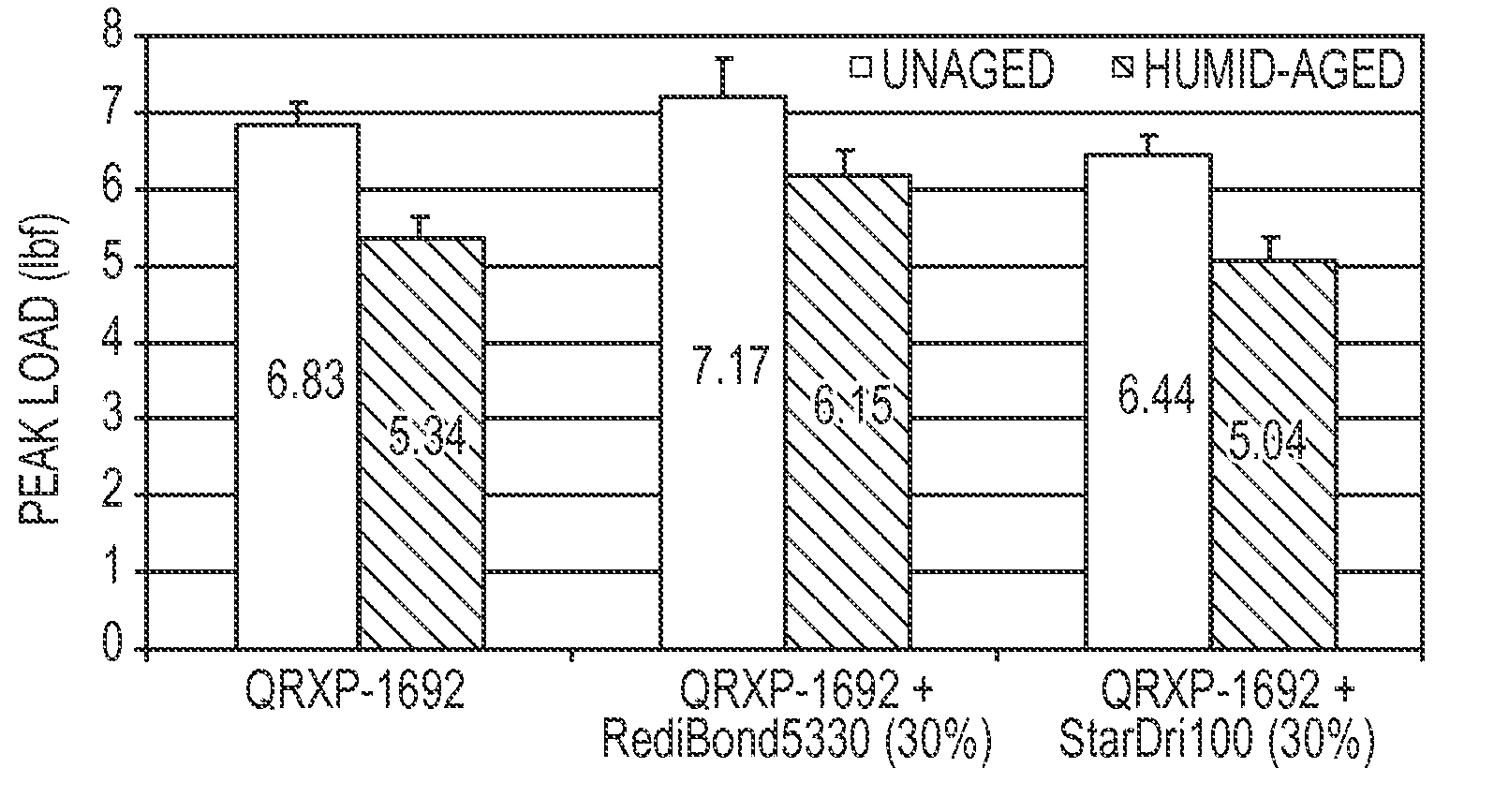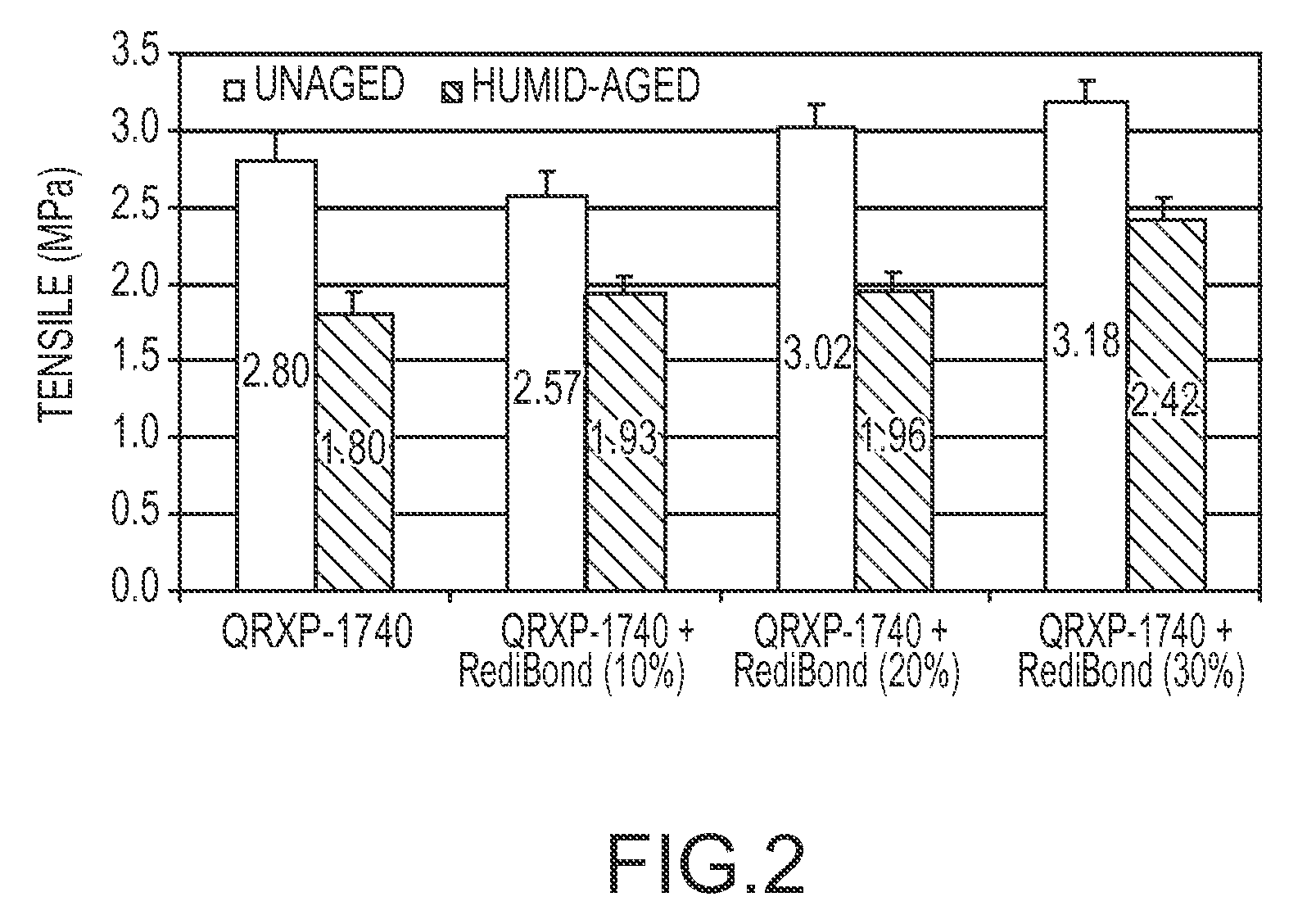Starch containing formaldehyde-free thermoset binders for fiber products
a technology of formaldehyde-free thermoset binders and fiber products, which is applied in the direction of adhesives, etc., can solve the problems of starch having a negative impact on the moisture resistance of a fiber product, and achieve the effects of reducing the need, enhancing the ability of withstanding the binder, and reducing the cost of binder components
- Summary
- Abstract
- Description
- Claims
- Application Information
AI Technical Summary
Benefits of technology
Problems solved by technology
Method used
Image
Examples
experiment # 1
Experiment #1: Handsheet Evaluations of Starches in Binder Formulations
[0030]A commercial polyacrylic acid binder (QRPX-1692 binder from Rohm & Haas Company) was combined with two starches of different molecular weights: (1) StarDri-100 (a low molecular weight (<10,000 g / mol) maltodextrin from Tate & Lyle, and (2) RediBOND 5440 (a high molecular weight (˜1,000,000 g / mol) cationic starch from National Starch and Chemical Company. The binder (QRXP-1962 binder from Rohm & Haas Company) is similar to binders described in U.S. Pat. No. 5,661,213 to Arkens et al., and U.S. Pat. No. 6.071,994 to Hummerich et al, the entire contents of both patents being herein incorporated by reference for all purposes. Also added to the combination was a polyol cross-linking agent (triethanolamine), a phosphorous-containing catalyst. In addition, a silane coupling agent ((3-glycidoxypropyl)methyldiethoxysilane) made up about 1%, by wt., of the combined mixture to enhance the binding between the fibers and...
experiment # 2
Experiment #2: Tensile Strength Tests for Another Polyacrylic Binder and Starch
[0035]Another polyacrylic acid binder (QRXP-1740 from Rohm & Haas Company) was combined varying concentrations of a high molecular weight cationic starch (RediBOND5330). The QRXP-1740 binder composition includes a polyacrylic acid, a low molecular weight polyacid, a polyol cross-linker, and a phosphorous-containing catalyst. In addition, a silane coupling agent, (3-glycidoxypropyl)methyldiethoxysilane, was added to the binder at about 1.6% weight. The pH of the binder composition was adjusted to 2.8. The binder composition and glass beads were mixed together, and then pressed into molds of a “dogbone” shape to form test samples. The molded samples were then dried and cured in an oven at 200° C. for 20 minutes. The LOI of the dog bone samples is 2.4%.
[0036]Dogbone tensile tests were conducted on the binders both before and after they were aged under hot and humid conditions. The aging process involved expo...
experiment # 3
Experiment #3: Tensile Strength Tests for SMAc Binder and Starch
[0038]A carboxyl-containing synthetic binder, made from copolymers of styrene maleamic acid (SMAc) mixed with a triethanolamine (TEA) cross-linker, was combined with a high molecular weight cationic starch (RediBOND5330). Additional details on the formation of the SMAc may be found in U.S. patent application Ser. No. 11 / 799,904 filed May 3, 2007 and titled “Binding of Fibrous Material Utilizing a Crosslinked Polyamic Acid,” the entire contents of which is herein incorporated by reference for all purposes. In addition 0.8%, by wt., of aminopropylsilane was added to the binder as a coupling agent between the resin and glass.
[0039]More Dogbone tensile tests were conducted on the binders both before and after they were aged under hot and humid conditions. The aging process involved exposing a dogbone sample containing the cured binder to air at a temperature of 120° F., with 95% relative humidity for 24 hours. Table 3 shows...
PUM
| Property | Measurement | Unit |
|---|---|---|
| Fraction | aaaaa | aaaaa |
| Fraction | aaaaa | aaaaa |
| Molar mass | aaaaa | aaaaa |
Abstract
Description
Claims
Application Information
 Login to View More
Login to View More - R&D
- Intellectual Property
- Life Sciences
- Materials
- Tech Scout
- Unparalleled Data Quality
- Higher Quality Content
- 60% Fewer Hallucinations
Browse by: Latest US Patents, China's latest patents, Technical Efficacy Thesaurus, Application Domain, Technology Topic, Popular Technical Reports.
© 2025 PatSnap. All rights reserved.Legal|Privacy policy|Modern Slavery Act Transparency Statement|Sitemap|About US| Contact US: help@patsnap.com



